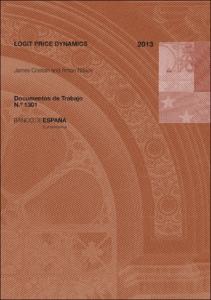Logit price dynamics
Authors
Issue Date
6-Feb-2013
Physical description
53 p. : fórmulas, gráf., tab.
Abstract
Proponemos un modelo cuasi racional de ajustes de precios en el mercado minorista que es coherente con la evidencia micro y macro de la dinámica de los precios. Nuestro marco está basado en la idea de que evitar errores en las decisiones implica un coste. Dada la asumida función del coste de evitar errores, los momentos escogidos para cambiar los precios se determinan por un logit binario ponderado, mientras que los precios escogidos se determinan por un logit multinomio. Incorporamos este comportamiento en un modelo DSGE, estimamos la función de costes de decisión ajustando los datos micro y simulamos la dinámica agregada utilizando un algoritmo manejable de agentes heterogéneos. Tanto los errores en los precios que establecen las empresas como los errores en los momentos escogidos para cambiar son relevantes para nuestros resultados. Los errores del primer tipo ayudan al modelo a reproducir algunas observaciones sorprendentes de los datos micro, como la coexistencia de cambios de precios pequeños y grandes, el comportamiento de la probabilidad de ajuste en función de la edad de los precios, y la variabilidad relativa de los precios y los costes. Los errores del segundo tipo aumentan los efectos reales de shocks monetarios, reduciendo la correlación entre el valor de ajustar y la probabilidad de ajuste (es decir, reduciendo el «efecto de selección»). Permitir ambos tipos de errores también ayuda a reproducir los efectos de la inflación sobre el comportamiento del ajuste de los precios. Nuestro modelo de fijación de precios sujeto a errores se parece en muchos aspectos al modelo de costes de menú estocásticos (CME), pero tiene menos parámetros libres que la mayoría de los modelos CME y, a diferencia de estos modelos, no requiere el supuesto implausible de que los costes de menú estén distribuidos idénticamente y de manera independiente (...)
We propose a near-rational model of retail price adjustment consistent with microeconomic and macroeconomic evidence on price dynamics. Our framework is based on the idea that avoiding errors in decision making is costly. Given our assumed cost function for error avoidance, the timing of firms’ price adjustments is determined by a weighted binary logit, and the prices they choose are determined by a multinomial logit. We build this behavior into a DSGE model, estimate the decision cost function by matching microdata, and simulate aggregate dynamics using a tractable algorithm for heterogeneous-agent models. Both errors in the prices firms set, and errors in the timing of these adjustments, are relevant for our results. Errors of the first type help make our model consistent with some puzzling observations from microdata, such as the coexistence of large and small price changes, the behavior of adjustment hazards, and the relative variability of prices and costs. Errors of the second type increase the real effects of monetary shocks, by reducing the correlation between the value of price adjustment and the probability of adjustment, (i.e., by reducing the "selection effect"). Allowing for both types of errors also helps reproduce the effects of trend infl ation on price adjustment behavior. Our model of error-prone pricing in many ways resembles a stochastic menu cost (SMC) model, but it has less free parameters than most SMC models have, and unlike those models, it does not require the implausible assumption of i.i.d. adjustment costs. Our derivation of a weighted logit from control costs oers an alternative justication for the adjustment hazard derived by Woodford (2008). Our assumption that costs are related to entropy is similar to the framework of Sims (2003) and the subsequent "rational inattention" literature. However, our setup has the major technical advantage (...)
We propose a near-rational model of retail price adjustment consistent with microeconomic and macroeconomic evidence on price dynamics. Our framework is based on the idea that avoiding errors in decision making is costly. Given our assumed cost function for error avoidance, the timing of firms’ price adjustments is determined by a weighted binary logit, and the prices they choose are determined by a multinomial logit. We build this behavior into a DSGE model, estimate the decision cost function by matching microdata, and simulate aggregate dynamics using a tractable algorithm for heterogeneous-agent models. Both errors in the prices firms set, and errors in the timing of these adjustments, are relevant for our results. Errors of the first type help make our model consistent with some puzzling observations from microdata, such as the coexistence of large and small price changes, the behavior of adjustment hazards, and the relative variability of prices and costs. Errors of the second type increase the real effects of monetary shocks, by reducing the correlation between the value of price adjustment and the probability of adjustment, (i.e., by reducing the "selection effect"). Allowing for both types of errors also helps reproduce the effects of trend infl ation on price adjustment behavior. Our model of error-prone pricing in many ways resembles a stochastic menu cost (SMC) model, but it has less free parameters than most SMC models have, and unlike those models, it does not require the implausible assumption of i.i.d. adjustment costs. Our derivation of a weighted logit from control costs oers an alternative justication for the adjustment hazard derived by Woodford (2008). Our assumption that costs are related to entropy is similar to the framework of Sims (2003) and the subsequent "rational inattention" literature. However, our setup has the major technical advantage (...)
Publish on
Documentos de Trabajo / Banco de España, 1301
Subjects
Nominal rigidity; Logit equilibrium; State-dependent pricing; Near rationality; Information-constrained pricing; Nominal; Equilibrio logit; Fijación de precios dependiente del Estado; Cuasi racionalidad; Fijación de precios con información restringida; Teoría de juegos y de la negociación; Renta, empleo y precios; Información e incertidumbre
Appears in Collections:












